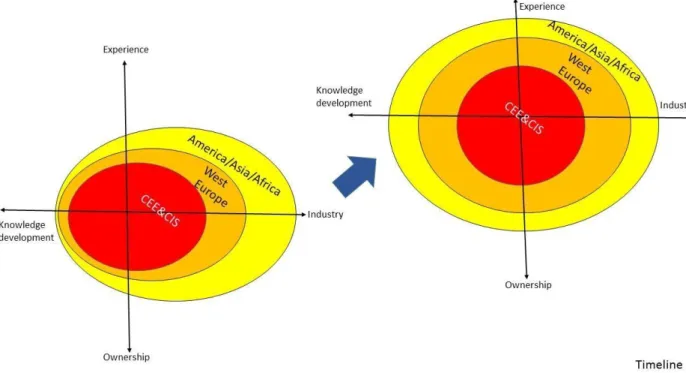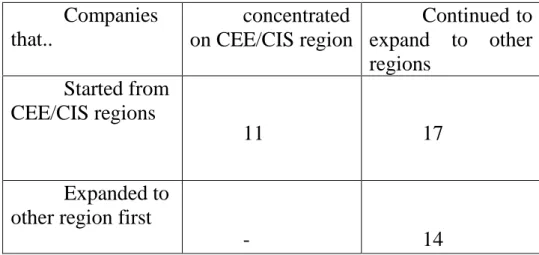Theoretical underpinnings of the research
The concept of dynamic capabilities
Furthermore, there are advantages of dynamic capabilities in the process of technology adoption as it is positively influenced by externalities, slack resources, entrepreneurship and absorptive capacity. One of them, dynamic learning mechanism, can be one of the decisive factors for the development of dynamic capabilities for further utilization of market and hierarchy management. (Lee&Lin, Chen&Shyr, 2011). This finding makes alliances and acquisitions quite an interesting measure of dynamic capabilities in our study.
Dynamic capabilities and internationalization of companies from emerging markets
Moreover, such acquisitions can help emerging market multinationals to improve their image abroad (Madhok & Keyhani, 2012). Companies coming from emerging markets and especially the BRIC countries can learn something from their experience of investing in their overseas subsidiaries. All these studies show how important absorptive capacity is for emerging market firms in their internationalization efforts.
Dynamic capabilities of Russian and CEE companies
The analysis of the effects of dynamic capabilities in IT companies in Romania shows that the sources of dynamic capabilities can be different, but the creation of dynamic capabilities is always done through a strategic process. (Tuteanu&Serban, 2013). Before the collapse of the Soviet Union, there were no more than 500 Soviet companies operating abroad. In the 1990s, immediately after the dissolution of the Soviet Union, there were several cases of internationalization efforts of Russian companies in the CIS states.
According to Panibratov, 2010, despite the wide variety of motives and strategies, the internationalized Russian companies have two important features in common. However, most studies on the internationalization of companies from the BRIC countries focus on India and China. Russian companies of certain sectors, in particular the oil and gas industry, the energy sector and the banking sector, have been able to count on wide support from the state during the internationalization process and are to some extent under its control.
However, the countries that emerged after the collapse of the Soviet Union have different economic and political conditions. However, making education one of the company's top priorities today is vital for organizational learning. Organizational learning should be considered as a necessary tool for the successful development of the company in the future.
Now there is no clear systematization of the factors that have the most important influence on the dynamic capabilities of companies, and form the core competencies that leaves room for further research.
Conceptual framework and propositions
This is why it is possible that our assumption about the validity of all dynamic capabilities necessary for internationalization in this study will change in the process of data collection. In the context of dynamic capability development, it is important to mention that the various partnerships and alliances were particularly important for SOEs that chose to develop their knowledge and technology domestically. Statement 1: The goals and strategies of SOEs in Russia and CEE countries have changed after 25 years of development, as they concentrated on domestic markets in the 1990s, but since the mid-2000s, they are more eager and able to go abroad to expand which positively influenced their dynamic ability development.
This fact may also reflect the choice of dynamic capabilities necessary for internationalization among companies coming from Russia and the CEE region and changes in their development. In our study, we argue that the importance of specific dynamic capabilities has also changed due to the improved economic and operational pool of resources available to companies after 25 years of development. This is why we argue that the type of ownership also affected certain areas of dynamic competence development and competitiveness of companies abroad.
Overall, the framework shows how companies' priorities in choosing markets change over time as a result of the displacement of various factors that account for changes in the dynamic development of competences in these companies. In the first chapter, we first gave the analysis of the concept of dynamic capabilities and its main possibilities and contradictions. We have analyzed the existing literature on potential dynamic capabilities of international companies from Russia and CEE countries.
Based on the literature analysis, we decided to develop our proposals and create a conceptual framework that could potentially explain the factors that could explain the shift in the development of dynamic capabilities between companies from Russia and CEE countries.

Methodology
Research design
In accordance with the objectives of the research, we focused on a selection of companies operating internationally. The answers of the experts should give additional information about the factors that could influence the specific choice of dynamic capabilities of CEE companies and their way of internationalization. The results of the questionnaire will be used to emphasize or refute the findings of the survey and to obtain additional information about the trends of CEE companies.
After this thorough investigation of the companies' background, motives and stages in their internationalization process, 45 companies were selected for the further analysis. In the process of this categorization, additional factors are added to the analysis and to the further aggregation of the results. Once this phase is completed, we combine the experts' opinions and answers with our secondary information to check the accuracy of the analysis and the validity of the results and conclusions.
The edition of the Deloitte CE Top 500 report for 2016 ranked the largest companies from 18 countries in Central and Eastern Europe. The top 3 countries on this list in terms of the number of leading companies are Poland (182 companies), the Czech Republic (74 companies) and Hungary (67 companies). The list of companies includes companies that could have started internationalization already before 1991 - before the fall of the communist system, as well as companies that decided on this path immediately after 1991 or even in the late 2000s.
The main characteristics of the companies necessary for our study, including the objectives of acquisitions, alliances, stages of internationalization and other important factors are described in the research.
Data description
Car production is five times greater than before the company's takeover. Each acquisition diversifies the company's business profile as it has business units that have very different areas. The company is actively trying to expand its product portfolio, which is also a key to the company's success in the future.
However, the main focus is on the CEE region, as the company started its expansion precisely in the countries of Central and Eastern Europe. The company has also completed several acquisitions to gain access to distribution channels in more countries. This was also achieved through the active expansion of the company since 2005 after the purchase of three Bulgarian distribution companies.
In the 1990s, the company focused on the domestic market by acquiring Czech companies and expanding its portfolio. The company also diversified its portfolio, for example becoming an electricity supplier. The company seeks to expand its product offering and offer new services for organic growth.
Large investments from the state helped the company in the first phase of its development.
Results of data analysis
Main findings and dynamic capabilities validity
The cost advantage of CEE firms is often based on wage levels and asset prices, which may be lower in CEE economies. The capabilities of CEE firms have evolved in their home market environments, in which customers are more cost-sensitive and less loyal. CEE firms may perceive their abilities to best pursue low-cost strategies and therefore may feel disadvantaged compared to Western firms to compete in higher demand markets.
Another reason for CEE firms to start internationalizing in neighboring markets is that they may suffer from the liability of foreignness or other country image-related problems, such as the company's products being perceived as inferior or of lower quality in Western markets. In the case of the question about the state-owned and private companies, the opinions differ considerably. According to expert 5, CEE firms have done a lot in terms of technological and innovative catch-up.
According to expert 3, in order to grow and become successful, CEE firms must internationalize. Because of these pressures, CEE firms naturally had to internationalize to Western markets quickly and to the quality required there. We argue that the way CEE firms prefer to conduct their R&D has changed significantly over the past 25 years.
Collaboration, especially when it comes to research and development, is not really a strong point of CEE companies.

Discussion
We have discussed the findings that confirm the framework illustrating the main groups of factors that have somehow influenced the shift in the development of dynamic capabilities among Russian and CEE companies since 1990. The study examines in detail various reasons for specific sequence of dynamic capability development used. by the companies and shows how it gradually changed due to factors suggested in the conceptual framework. This study on dynamic capabilities of international companies from CEE region and Russia examines how the importance of certain dynamic capabilities has changed during the last 25 years.
This shows that the priorities and type of dynamic capabilities changed over time and their development changed as the companies adapted to changing economic and political conditions. The study also provides a better understanding of some factors that determined internationalization of some companies, but could not be linked to the direct influence of dynamic capability development. The study also has practical value for managers as it shows the complexity of factors influencing dynamic capability development and their evolution since the 1990s.
Managers should also assess all possible challenges that may arise in the process of internationalization and try to promote the dynamic capabilities of companies through alliances, innovations and continuous learning. Another interesting issue to be analyzed is that the institutions in Russia and the CEE region influence the development of dynamic capabilities and influence the internationalization of companies from these countries. Incumbent entry into new market niches: The role of experience and managerial choice in creating dynamic capabilities.
Dynamic capabilities as a mediator linking international diversification and innovative performance of firms in a developing economy.

